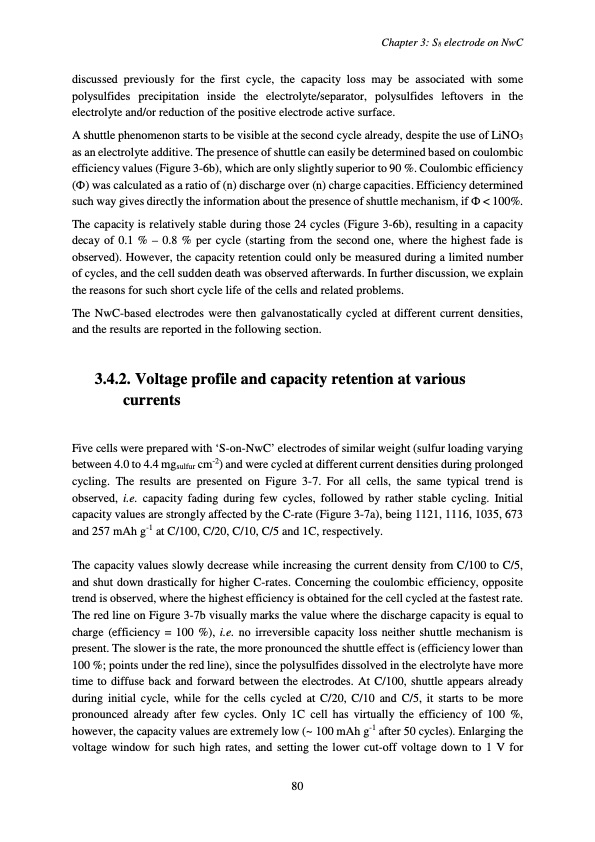
PDF Publication Title:
Text from PDF Page: 084
discussed previously for the first cycle, the capacity loss may be associated with some polysulfides precipitation inside the electrolyte/separator, polysulfides leftovers in the electrolyte and/or reduction of the positive electrode active surface. A shuttle phenomenon starts to be visible at the second cycle already, despite the use of LiNO3 as an electrolyte additive. The presence of shuttle can easily be determined based on coulombic efficiency values (Figure 3-6b), which are only slightly superior to 90 %. Coulombic efficiency (Ф) was calculated as a ratio of (n) discharge over (n) charge capacities. Efficiency determined such way gives directly the information about the presence of shuttle mechanism, if Ф < 100%. The capacity is relatively stable during those 24 cycles (Figure 3-6b), resulting in a capacity decay of 0.1 % – 0.8 % per cycle (starting from the second one, where the highest fade is observed). However, the capacity retention could only be measured during a limited number of cycles, and the cell sudden death was observed afterwards. In further discussion, we explain the reasons for such short cycle life of the cells and related problems. The NwC-based electrodes were then galvanostatically cycled at different current densities, and the results are reported in the following section. 3.4.2. Voltage profile and capacity retention at various currents Five cells were prepared with ‘S-on-NwC’ electrodes of similar weight (sulfur loading varying between 4.0 to 4.4 mgsulfur cm-2) and were cycled at different current densities during prolonged cycling. The results are presented on Figure 3-7. For all cells, the same typical trend is observed, i.e. capacity fading during few cycles, followed by rather stable cycling. Initial capacity values are strongly affected by the C-rate (Figure 3-7a), being 1121, 1116, 1035, 673 and 257 mAh g-1 at C/100, C/20, C/10, C/5 and 1C, respectively. The capacity values slowly decrease while increasing the current density from C/100 to C/5, and shut down drastically for higher C-rates. Concerning the coulombic efficiency, opposite trend is observed, where the highest efficiency is obtained for the cell cycled at the fastest rate. The red line on Figure 3-7b visually marks the value where the discharge capacity is equal to charge (efficiency = 100 %), i.e. no irreversible capacity loss neither shuttle mechanism is present. The slower is the rate, the more pronounced the shuttle effect is (efficiency lower than 100 %; points under the red line), since the polysulfides dissolved in the electrolyte have more time to diffuse back and forward between the electrodes. At C/100, shuttle appears already during initial cycle, while for the cells cycled at C/20, C/10 and C/5, it starts to be more pronounced already after few cycles. Only 1C cell has virtually the efficiency of 100 %, however, the capacity values are extremely low (~ 100 mAh g-1 after 50 cycles). Enlarging the voltage window for such high rates, and setting the lower cut-off voltage down to 1 V for 80 Chapter 3: S8 electrode on NwCPDF Image | Accumulateur Lithium Soufre

PDF Search Title:
Accumulateur Lithium SoufreOriginal File Name Searched:
WALUS_2015_archivage.pdfDIY PDF Search: Google It | Yahoo | Bing
Sulfur Deposition on Carbon Nanofibers using Supercritical CO2 Sulfur Deposition on Carbon Nanofibers using Supercritical CO2. Gamma sulfur also known as mother of pearl sulfur and nacreous sulfur... More Info
CO2 Organic Rankine Cycle Experimenter Platform The supercritical CO2 phase change system is both a heat pump and organic rankine cycle which can be used for those purposes and as a supercritical extractor for advanced subcritical and supercritical extraction technology. Uses include producing nanoparticles, precious metal CO2 extraction, lithium battery recycling, and other applications... More Info
| CONTACT TEL: 608-238-6001 Email: greg@infinityturbine.com | RSS | AMP |